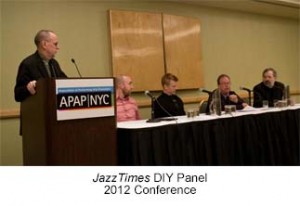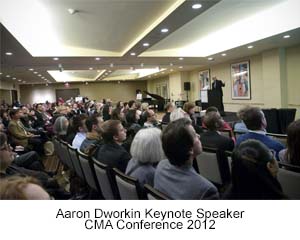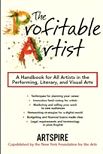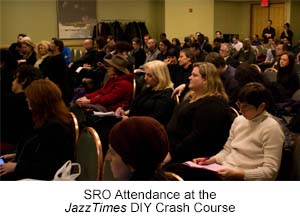Last week’s blog pointed to futurist John Naisbitt’s “Hi-Tech/Hi-Touch” projections with respect to several themes apparent at the Association of Performing Arts Professionals (APAP), Chamber Music America (CMA), Jazz Journalists Association (JJA), and JazzTimes organized conference held earlier this year in New York City, namely, that the more high technology we adopt, the more person-to-person, face-to-face interaction would be fostered, even demanded. What follows is a continuation of my observations while in attendance at these gatherings.*
JazzTimes DIY Crash Course
Lee Mergner, publisher and editor of JazzTimes, organized a one-day pre-APAP conference DIY crash course in conjunction with the APAP convention. The sessions reflected Naisbitt’s forecasts: “Music For Sale: New models for selling your music,” “Breaking Through the Clutter: Social media for publicity, promotion, and profit,” “New models for jazz performance and touring,” and “The jazz artist as small business owner and manager.” By the way, this one day course was filled to over-flowing, SRO.
 During the APAP conference, Mergner had also organized several other sessions under a “JazzConnect” banner: “Building jazz culture—local to global,” “Crowdfunding for jazz projects,” “Building Thriving Cultural Communities through Programming and Education,” “Platforms that move Jazz Forward,” “What jazz can teach us about winning audiences,” “NEA Jazz Masters & Jazz Futures: Paying It Forward,” and “Building A Jazz Future—Taking Action.” These sessions were all about folks in the jazz world taking charge of their futures. It was Naisbitt’s “networking” forecast—i.e., as a society we would move from hierarchies to networking—all over the place.
During the APAP conference, Mergner had also organized several other sessions under a “JazzConnect” banner: “Building jazz culture—local to global,” “Crowdfunding for jazz projects,” “Building Thriving Cultural Communities through Programming and Education,” “Platforms that move Jazz Forward,” “What jazz can teach us about winning audiences,” “NEA Jazz Masters & Jazz Futures: Paying It Forward,” and “Building A Jazz Future—Taking Action.” These sessions were all about folks in the jazz world taking charge of their futures. It was Naisbitt’s “networking” forecast—i.e., as a society we would move from hierarchies to networking—all over the place.
Jazz Journalists Association (JJA)
The JJA sessions, moderated by long-time founding president Howard Mandel, mounted parallel sessions: “Revolution in Media Relations: YOU are the Media,” “Town Hall on Media: What Works/Obstacles,” and “Getting Coverage in Local Media.” Again, all these sessions reflected the Naisbitt high-tech/hi-touch mantra. You could not help but come away from these sessions with such words as DIY, direct to audience, emotional contact, community, connection, marketing, and every manner of social media on your lips.
Chamber Music America (CMA): More of the Same
The 34th Annual Conference of CMA at the Westin was more of the same. As if a reference to Naisbitt’s implied DIY admonition, and an echo of the APAP conference’s “The Road Ahead” theme, the CMA conference was titled “Sound Off: Raising the Volume on Arts Advocacy.” A first morning, pre-conference session was devoted to “Strategies for Organizational Success,” in a way an extension of the DIY theme. The afternoon, pre-conference “Ask The Experts” sessions was a continuation of the APAP, JazzTimes, and JJA sessions: “Funding Raising,” (which could have easily been called “Crowdfunding”), “Social Media/Public Relations” and “Marketing and Branding.”
 The opening keynote address, “”Breaking the Sound Barrier,” was given by violinist and MacArthur award-winner Aaron Dworkin, founding president of the Detroit-based Sphinx Organization, who spoke eloquently (and with deft use of multimedia, including video) on his successful strategies for enlarging the base for classical music by battling cultural stereotypes and encouraging the participation of minority youth. Parallels to Venezuela’s highly successful “El Sistema” come to mind. El Sistema is a state foundation that watches over Venezuela’s 125 youth orchestras and the instrumental training programs which make them possible. El Sistema has 31 symphony orchestras. But its greatest achievement is the 250,000 children who attend its music schools around the country, 90 percent of them from poor socio-economic backgrounds. The glaring difference between the two is that “El Sistema” is government supported. The Sphinx Organization is clearly not, but is instead working from a self-reliance (i.e., DIY) approach.
The opening keynote address, “”Breaking the Sound Barrier,” was given by violinist and MacArthur award-winner Aaron Dworkin, founding president of the Detroit-based Sphinx Organization, who spoke eloquently (and with deft use of multimedia, including video) on his successful strategies for enlarging the base for classical music by battling cultural stereotypes and encouraging the participation of minority youth. Parallels to Venezuela’s highly successful “El Sistema” come to mind. El Sistema is a state foundation that watches over Venezuela’s 125 youth orchestras and the instrumental training programs which make them possible. El Sistema has 31 symphony orchestras. But its greatest achievement is the 250,000 children who attend its music schools around the country, 90 percent of them from poor socio-economic backgrounds. The glaring difference between the two is that “El Sistema” is government supported. The Sphinx Organization is clearly not, but is instead working from a self-reliance (i.e., DIY) approach.
Other general session speakers included Randy Cohen, vice president for research and policy at American for the Arts. Cohen developed the National Arts Policy Roundtable, an annual convening of leaders who focus on the advancement of American culture.
The Profitable Artist
 As if on cue, and just in time, the New York State Foundation for the Arts (NYFA), together with Artspire, have published The Profitable Artist: A Handbook for All Artists in the Performing, Literary, and Visual Arts (Allworth Press, New York City, 219 pp, 2012). This excellent, well organized, and highly readable book is an outgrowth of NYFA’s highly successful five-week “The Artist as Entrepreneur Bootcamp” held in the summer. Divided into 21 chapters, the book covers Strategic Planning, Finance, Art and the Law, Selling and Promoting, and Fundraising.
As if on cue, and just in time, the New York State Foundation for the Arts (NYFA), together with Artspire, have published The Profitable Artist: A Handbook for All Artists in the Performing, Literary, and Visual Arts (Allworth Press, New York City, 219 pp, 2012). This excellent, well organized, and highly readable book is an outgrowth of NYFA’s highly successful five-week “The Artist as Entrepreneur Bootcamp” held in the summer. Divided into 21 chapters, the book covers Strategic Planning, Finance, Art and the Law, Selling and Promoting, and Fundraising.
As Michael L. Royce, NYFA Executive Director writes in the Foreword:
The New York Foundation for the Arts believes than an artist, no matter the discipline, needs three components to build a career in his or her field: access to funds, entrepreneurial skills, and an opportunity to showcase work. At NYFA, we create programs to provide all three as our mission is to empower artists at critical stages in their creative lives. . . . We also advocate for artists to undergo professional development training to cultivate successful careers. Master of Fine Arts (MFA) and Doctor of Fine Arts (DFA) programs frequently overlook the importance of business and professional skills. MFA and DFA students hone their craft in their course of study, but recipients typically graduate with little to no applied knowledge of professional artists’ business practices.
Royce also points out that the book’s central unique benefit is that it covers all arts, not just one.
The Road Ahead: Putting It All Together
![blog 21 Collaboration[1] Putting it All Together](http://www.eugenemarlow.com/wp-content/uploads/2012/07/blog-21-Collaboration1-300x300.jpg) To echo the theme of APAP’s 2012 conference and to again refer to John Naisbitt’s trend forecast (“From short term to long term perspective”), the over-arching message in all this is that what worked for the previous generation of musicians, all artists notwithstanding, does not work anymore in today’s environment, and won’t work in the future. There is no doubt that musicians, jazz musicians included, need to advocate for themselves. Waiting for the phone to ring is not going to work. Expecting presenters to fall over themselves to provide concerts or gigs won’t happen unless the individual musician takes aggressive steps to be known. Expecting a manager to “do the right thing” all the time is a disaster waiting to happen. Musicians need to know the language of business and have an understanding of the business side of the music business. In this vein, the CD recording may have been at one time a source of revenue, but today and looking to the future, this same product is now a promotional tool, and perhaps a salable product at a live gig. “Putting It All Together,” to quote the title of a song from Stephen Sondheim’s “Sunday in The Park With George,” is now the mission for artists of all stripes, including jazz musicians.
To echo the theme of APAP’s 2012 conference and to again refer to John Naisbitt’s trend forecast (“From short term to long term perspective”), the over-arching message in all this is that what worked for the previous generation of musicians, all artists notwithstanding, does not work anymore in today’s environment, and won’t work in the future. There is no doubt that musicians, jazz musicians included, need to advocate for themselves. Waiting for the phone to ring is not going to work. Expecting presenters to fall over themselves to provide concerts or gigs won’t happen unless the individual musician takes aggressive steps to be known. Expecting a manager to “do the right thing” all the time is a disaster waiting to happen. Musicians need to know the language of business and have an understanding of the business side of the music business. In this vein, the CD recording may have been at one time a source of revenue, but today and looking to the future, this same product is now a promotional tool, and perhaps a salable product at a live gig. “Putting It All Together,” to quote the title of a song from Stephen Sondheim’s “Sunday in The Park With George,” is now the mission for artists of all stripes, including jazz musicians.
There is much more to be said, but here is one final point. For several years now there has been much complaining about too many musicians chasing too few gigs, concerts, positions; too many CDs in the marketplace for radio programmers to spin. And so on. As a result, jazz musicians, in particular, have been put at a disadvantage economically. It is also true, however, that despite the apparent shrinkage of jazz radio, traditional jazz clubs, and the number of jazz/arts/culture critics, perhaps what the future holds is this: while real talent will still prevail, it will be the entrepreneurial-minded musicians who know how to handle the business side of the business (including incorporating new media and social media into their professional portfolio) who will find and create the opportunities to sustain themselves.
*2013 Conferences:
Jazz Connect (JazzTimes) January 9-10
Association of Performing Arts Professionals (APAP) January 10-11
Jazz Journalists Association (JJA) January 11-15
Chamber Music America (CMA) January 17-20
Please write to me at meiienterprises@aol.com if you have any comments on this or any other of my blogs.
Eugene Marlow, Ph.D.
October 8, 2012
© Eugene Marlow 2012


